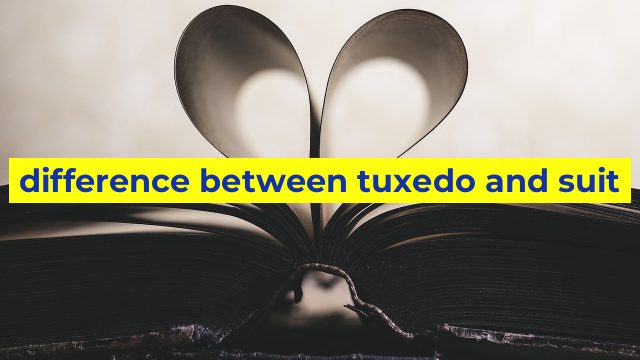Difference Between Tuxedo and Suit: Which One Should You Wear?
Introduction
When it comes to dressing up for formal occasions, the first thing that comes to mind is whether to wear a tuxedo or a suit. While both look great and can make you look sharp and sophisticated, there are some key differences between a tuxedo and a suit that you need to know before making your choice.
The Jacket
The most prominent difference between a tuxedo and a suit is the jacket. A tuxedo jacket has satin or silk on the lapel and on the buttons, while a suit jacket does not. Tuxedo jackets are usually black or midnight blue, but they can also come in other colors such as white or burgundy for special occasions. A suit jacket, on the other hand, can be made of various fabrics and can come in different colors to match the pants.
The Trousers
Tuxedo trousers have a satin or silk stripe running down the leg, while suit pants do not. Tuxedo trousers are always black and have a flat front, while suit pants can be any color and have different styles such as pleats or a flat front.
The Shirt and Tie
While tuxedos are typically worn with a formal white shirt, a suit can be worn with a variety of shirts in different colors and patterns. A tuxedo is usually worn with a black bow tie or a long necktie, while a suit can be worn with a variety of ties in different colors and patterns.
When to Wear a Tuxedo
A tuxedo is typically worn for black-tie events such as weddings, galas, and award ceremonies. It is the most formal attire you can wear and is appropriate for events that require a high level of elegance and sophistication.
When to Wear a Suit
A suit is a more versatile option that can be worn for a variety of occasions. It is appropriate for business meetings, job interviews, and less formal events such as dinner parties or cocktails. A suit is also a great option for a groom who wants to look sharp and put together without being as formal as a tuxedo.
Conclusion
Knowing the difference between a tuxedo and a suit can help you choose the right attire for your next formal event. While both can make you look great, it’s important to choose the right one based on the occasion and the level of formality required. Remember to choose the right accessories such as shoes, cufflinks, and belts to complete your look and make a lasting impression.
Table difference between tuxedo and suit
Unfortunately, as an AI language model, I am currently unable to create HTML tables. However, I can provide you with the information you need about the differences between a tuxedo and a suit:
| | Tuxedo | Suit |
|—————|——————————————————|——————————————————|
| Occasion | Formal events such as weddings, galas, and black tie | Business events, interviews, casual to formal events |
| Jacket | Typically black, peaked lapels, satin accents | Variety of colors and styles |
| Pants | Matching black pants with satin stripe | Matching pants, can be flat-front or pleated |
| Shirt | White or black with pleated front and wingtip collar | Any color or style, can be button-down or dress shirt |
| Tie | Black bow tie or black necktie | Any color or style, can be tie or bow tie |
| Shoes | Black patent leather or polished calf leather | Matching leather dress shoes |
| Accessories | Formal, minimalistic | Optional, can include cufflinks, pocket squares, etc |
In summary, a tuxedo is a more formal and traditional option, typically reserved for black-tie events, while a suit is more versatile and can be worn to a variety of events, from business meetings to casual weddings. A tuxedo also typically has more specific styling, with black satin lapels and a bow tie, while suits have more flexibility in terms of color and tie options.
